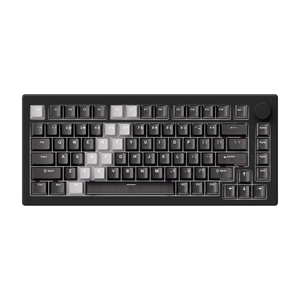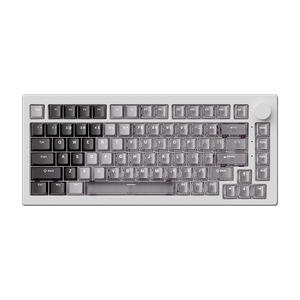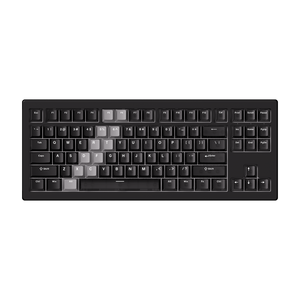The keyboard is an essential input tool, whether for gaming or typing. However, long-term keyboard use can lead to health problems such as wrist pain. Ergonomic keyboards were developed to address these problems. Through scientifically sound and sensible design, the ergonomic keyboard allows our hands to maintain a natural and comfortable posture while typing, thereby reducing strain on the wrist. Today, let's learn more about ergonomic keyboards.
What is an ergonomic keyboard?
An ergonomic keyboard is designed to provide greater comfort, promote a more natural wrist position, and improve overall posture. In other words, it can withstand extended use without causing serious discomfort.
There are many different types of ergonomic keyboards, each designed in a different way. Therefore, you'll find keyboards with different shapes, heights, key layouts, and so on. However, all ergonomic keyboards have one thing in common: they're more comfortable to type on.
Types of ergonomic keyboards
Ergonomics isn't a completely measurable value; therefore, there's no clear conclusion as to which keyboard is truly ergonomic. All keyboards can provide a comfortable typing experience over extended periods and can be considered good ergonomic keyboards.
| type | Features | Advantages | Disadvantages | Examples |
|---|---|---|---|---|
| Split keyboards | Divided into two separate sections | Reduces the load, customizable layout | Steep learning curve, uncomfortable at first | Kinesis Freestyle Edge |
| Tilted keyboards | Slight tilt in the middle to keep the wrist neutral | Neutral wrist position, reduces strain | Uncomfortable at first, limited adjustment options | Logitech Ergo K860 |
| Contoured keyboards | Curved shape that corresponds to the angles of the hand | Comfortable, familiar layout | Limited relief of the wrist | Logitech Wave K350 |
| Vertical keyboards | Arranged vertically, promotes the “handshake” position | Reduces wrist rotation, minimizes strain | Long adjustment time, slow typing | Microsoft Sculpt Vertical |
| One-handed keyboards | Compact design for one-handed use | Efficient for gaming, compact layout | Not suitable for regular typing | ErgoDox EZ One-Handed |
| Keyboards with adjustable angles | Adjustable tilt for individual comfort | Flexible tilt adjustments for more comfort | Limited ergonomic benefits without other features | Kensington Ergonomic Split Keyboard |
| Ergonomic keypads | Compact keypads for a natural wrist position | Practical for limited use, space-saving | Limited functionality for a complete work environment | Logitech K400 Plus |
Of course, there are other ergonomic keyboards not listed here, such as some people who believe that a 60% keyboard is ergonomic. Because these keyboards have a smaller footprint, they reduce the distance your fingers have to travel to reach the keys.

Advantages of an ergonomic keyboard
1. Improved wrist comfort
Ergonomic keyboards are designed to position your wrists in a natural position, reducing overall stress on your wrists and hands. Of course, different ergonomic keyboards take different approaches to determining the position of your hands and wrists for maximum comfort.
2. Promote shoulder comfort
Generally, ergonomic keyboards keep your arms straight in front of you, making it easier to keep your shoulders back and your back straight. Even if you move your arms from an inverted "V" position to directly in front of your shoulders, you can feel the difference in your shoulders and overall posture.
3. Increase typing speed and productivity
A new ergonomic keyboard comes with a learning curve as you get used to its shape and key layout. During this time, your typing speed and productivity may slow. However, once you adjust, you'll likely type faster because your hands and wrists are more comfortable, reducing the need for frequent breaks. With improved comfort, your productivity will naturally increase.
How long does it take to get used to an ergonomic keyboard?
I've listed the different types of ergonomic keyboards above, each with unique designs and varying difficulty of adjustment.
Like the split keyboard, which is divided into two parts, the hands can be naturally separated, reducing wrist twisting. However, for users accustomed to the traditional one-piece keyboard, this design will require some time to get used to the separate typing method.
Tilted keyboards, such as the X-Bows Lite, place the wrists in a more natural position; the change in key layout also requires some adjustment.
Additionally, some ergonomic keyboards with dedicated function keys or custom key layouts may require additional time to learn and adjust to.
While initial discomfort is normal, most people adjust within one to three weeks and begin to benefit from the comfort and health benefits of an ergonomic design.

How to choose the right ergonomic keyboard?
1. Understand the ideal typing position
First, when it comes to choosing the right ergonomic keyboard, we need to know which typing position is ideal.
- Stand up, relax your arms at your sides and turn your elbows.
- Your forearms and palms should be aligned, with your hands slightly narrower than shoulder-width apart.
- The palms should face forward, with the fingers naturally bent.
This is the ideal ergonomic position for comfortable typing.

2. Choose the most important features based on your habits
You can choose the most important feature you want to focus on or combine them to find the keyboard that suits you.
- Raised center point: Ensures your wrists remain in a neutral position and prevents strain.
- Split design: Allows you to separate your hands, reducing shoulder and wrist tension.
- Wrist/Palm Rest: Supports your wrists to avoid strain during long typing sessions.
- Customizable layout: Adapts to your finger length and typing style, ensuring comfort and efficiency.
3. Consider the brand and price
Well-known brands of ergonomic keyboards are generally more reliable in terms of quality, design, and customer service, but the price can also be relatively high. While some niche or lesser-known keyboard brands may be more affordable, there may be certain risks in terms of quality and performance.
Therefore, you should consider your budget and quality requirements when making your selection. If you have high demands on the quality and user experience of the keyboard and have a sufficient budget, you can choose high-priced products from well-known brands.
If you only use the keyboard occasionally or are more concerned about the price, you can also consider products from niche brands that offer good value for money.
4. Test the keyboard before buying
We always recommend testing the keyboard before purchasing. It's best to try it out in person. Feel the key softness, responsiveness, and overall comfort to see if it's a good fit for you. Testing allows you to check the ergonomics and ensure the keyboard is right for you.
Conclusion
Ergonomic keyboards improve comfort and productivity by adapting to users' natural posture and movements. They promote a healthy typing experience by better aligning hardware and software with human needs. These keyboards continue to evolve with continuous ergonomic and technological advancements, offering better options for frequent keyboard users seeking more comfort and support.
FAQ
Can ergonomic keyboards help with wrist pain?
Yes, by promoting a more natural wrist position, ergonomic keyboards can reduce wrist pain. By keeping the wrists in a neutral position, features like split and tilted designs reduce strain. Wrist rests provide additional support. The keyboard performs best when used with proper posture and regular breaks.
Are split keyboards really more ergonomic?
Yes, many users find split keyboards more ergonomic. They reduce shoulder and wrist strain by allowing a more natural hand position. They reduce discomfort by keeping the wrists in a neutral position. However, they aren't necessary for everyone, and there's a learning curve. Split models may not be very helpful if you don't have trouble using a traditional keyboard.
Are Alice keyboards ergonomic?
The Alice keyboard is ergonomic in some ways. The left-right split design of Alice keyboards generally helps improve wrist posture while typing and reduces wrist fatigue and twisting. At the same time, Alice keyboards relocate some keys to new positions without changing the overall standard QWERTY layout. This makes it easier for the fingers to reach these keys, reducing the force and distance of finger movement and ultimately reducing strain on the wrists, arms, and shoulders.















